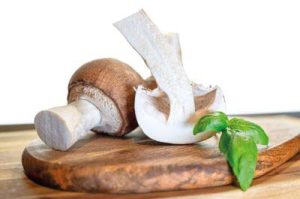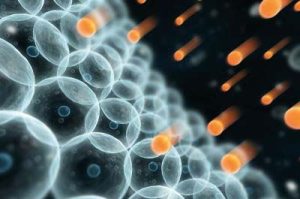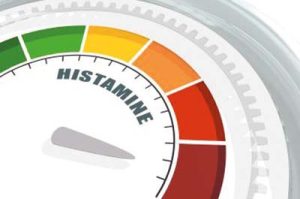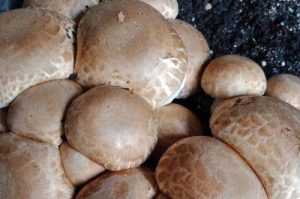
Every person is unique!
Our experienced team will be happy to advise you in detail and free of charge on all matters relating to your health. Book your consultation appointment now:
Agaricus blazei murrill ABM - The vital mushroom for a healthy immune system
July 15, 2021
Dr. Dorothee Bös et al.
Hardly any other mushroom strengthens and stabilizes the immune system as effectively as the almond mushroom. Autoimmune patients in particular benefit from its balancing effect on the immune system. It is also a good support in the treatment of cancerous diseases and reduces oxidative stress in the body. Learn everything you need to know about this medicinal mushroom and how it may be able to help you.
What is the Agaricus blazei murrill?
The vital mushroom discovered three times
The medicinal mushroom Agaricus blazei murrill, or “ABM” for short, has a rather unusual story to tell about its discovery. Thus, its name comes from the biologist Murrill, who first described it in 1974. A few years later, however, it turned out that exactly the same mushroom was already listed under the name Agaricus brasiliensis. The epithet “brasiliensis” is derived from its home in the Brazilian rainforests. Finally, in 2005, scientists discovered during a DNA sequence analysis that ABM or Agaricus brasiliensis has exactly the same genetic material as Agaricus subrufescens Peck. This fungus had already been discovered and cataloged in 1893 by a researcher named Peck.
This story shows how difficult sometimes even experts find it to clearly identify mushrooms. Nevertheless, ABM is now a widely used and popular medicinal mushroom in mycotherapy. We will stick to its most common name “Agaricus blazei murrill” and the abbreviation “ABM” in this article. In different countries, this medicinal mushroom has local names in addition to its biological name. Thus, in German it is also called “Mandelpilz” or “Brazilian Almond Egerling”, which it owes to its almond-like aroma. In its native Brazil, it bears lofty titles such as “Cogumelo de deus” (Mushroom of the God) and “Cogumelo do sol” (Sun Mushroom). The last name it received because of its preference for sunny locations, which is rather unusual among mushrooms. This characteristic also resonates in the English name “Royal Sun Agaricus”.
A relative of the button mushroom
Cultivation
What's in the ABM?
 Like all edible mushrooms, the almond mushroom is an extremely healthy food. It is rich in protein, which accounts for up to 45% of its dry matter. It contains all the essential amino acids, i.e. those that must be supplied to the body from the outside. The fat content is rather low at less than 3%. Nevertheless, fatty acids, especially polyunsaturated linoleic acid, play an important role in human health. Also very valuable are the dietary fibers from the vital mushroom. They can account for up to 20% of the dry matter. These include its most important health-promoting substances: polysaccharides. In particular, the polysaccharide beta-D-glucan is contained in ABM in large quantities and supports the immune system in its work quite significantly. Some polysaccharides combine with proteins, resulting in glycoproteins. These also have a positive effect on our organism.
Like all edible mushrooms, the almond mushroom is an extremely healthy food. It is rich in protein, which accounts for up to 45% of its dry matter. It contains all the essential amino acids, i.e. those that must be supplied to the body from the outside. The fat content is rather low at less than 3%. Nevertheless, fatty acids, especially polyunsaturated linoleic acid, play an important role in human health. Also very valuable are the dietary fibers from the vital mushroom. They can account for up to 20% of the dry matter. These include its most important health-promoting substances: polysaccharides. In particular, the polysaccharide beta-D-glucan is contained in ABM in large quantities and supports the immune system in its work quite significantly. Some polysaccharides combine with proteins, resulting in glycoproteins. These also have a positive effect on our organism.
Other important substances in the treatment of diseases with the help of Agaricus blazei murrill are its steroids (e.g. ergosterol, blazeispirol A and C, blazein), phenols and the glucomannan. In trace elements and minerals are especially:
- Magnesium
- Potassium
- Phosphorus
- Iron
- Copper
- Selenium
- Manganese (regulates insulin production)
- Zinc (strengthens the immune system)
to name. Just as in many edible mushrooms, several B vitamins are found in ABM, namely thiamine (B1), riboflavin (B2), niacin (B3) and B6. By the way, its almond-like fragrance is due to its benzaldehyde content.
Simply request free information brochures now!

After you have sent the completed form, you will receive an e-mail with a download link.
What are the effects of Agaricus blazei murill?
The spectrum of action of the almond mushroom is broad. First of all, like all other vital mushrooms, it supports the detoxification of the body. A lower concentration of toxins is synonymous with a relief of the immune system and organs. In addition, its effectiveness in cancer should be emphasized above all. We will discuss these and other significant uses of the ABM in more detail in a moment. At this point, it should only be mentioned that the Brazilian vital mushroom has antithrombotic and blood pressure lowering properties in addition to the effects described below.
EXPERIENCE REPORTS
"After 80 chemotherapies, I was again diagnosed with two tumors. I was given up by conventional medicine. That's when I learned about the healing properties of mushrooms and grasped at the last straw. Today I am tumor-free and cured of cancer." H. P.
Cancer
 Cancer is one of the most important areas of research in which scientists are studying the effects of ABM. For example, the PubMed medical database contains more than 100 scientific articles on this topic. In Google-Scholar there are even more than 4000 hits. For the following types of cancer, the use of Agaricus blazei murrill has already been shown to have a positive effect:
Cancer is one of the most important areas of research in which scientists are studying the effects of ABM. For example, the PubMed medical database contains more than 100 scientific articles on this topic. In Google-Scholar there are even more than 4000 hits. For the following types of cancer, the use of Agaricus blazei murrill has already been shown to have a positive effect:
- Liver cancer
- Abdominal Cancer
- Colorectal cancer
- Stomach cancer
- Prostate Cancer
- Thyroid Cancer
- Pancreatic Cancer
- Lung cancer
- Skin cancer
- Liver cancer
- Leukemia
- Brain tumors
Researchers attribute the main effect to the beta-D-glucans contained in ABM. Glycoproteins probably also play an important role, although it is mainly the protein part that matters here. In addition, blazeispirol A and C and blazein possess antitumor powers.
Fighting cancer on many levels
Companion to conventional cancer therapy
Strengthening the immune system
In addition to zinc, beta-glucans and glycoproteins are primarily responsible for supporting the immune system. In this process, the complex chemical structure of polysaccharides triggers an equally complex cascade of effects.  For example, they improve communication between leukocytes, which are so important for defense, by stimulating the formation of cytokines and interleukins 8, 1 and 6. Similarly, ABM stimulates the proliferation and differentiation of macrophages and monocytes. As a result, the activity of the cytotoxic T cells increases, which stimulate the B cells to produce more antibodies by means of the cytokine IL-6. In addition, the ingredients of Agaricus blazei murrill medicinal mushroom increase the formation of:
For example, they improve communication between leukocytes, which are so important for defense, by stimulating the formation of cytokines and interleukins 8, 1 and 6. Similarly, ABM stimulates the proliferation and differentiation of macrophages and monocytes. As a result, the activity of the cytotoxic T cells increases, which stimulate the B cells to produce more antibodies by means of the cytokine IL-6. In addition, the ingredients of Agaricus blazei murrill medicinal mushroom increase the formation of:
- Tumor necrosis factor alpha (apoptosis)
- natural killer cells
- Immunoglobulin M (antibody of the humoral immune defense)
- Immunoglobulin G (antiviral and -bacterial)
Thanks to these multiple mechanisms, the intake of ABM in diseases such as bronchitis and HIV provides attenuation of disease symptoms. In this context, its anti-inflammatory properties also play an important role. Over the years, almond mushroom has also proven itself time and again in the treatment of migraines and chronic fatigue thanks to its immune-boosting powers.
However, as an adaptogen, Agaricus blazei murrill can not only increase immune activity, but bring it into a healthy balance. That is why it is a helpful companion for allergies and asthma. In addition, mycotherapists like to use it for the following autoimmune diseases:
- Hashimoto thyroiditis
- Multiple sclerosis
- Rheumatism
- Chronic inflammatory bowel diseases (e.g. Crohn’s disease, ulcerative colitis)
- Fibromyalgia and other diseases
Fighting viruses and bacteria with the almond mushroom
In medical studies, Agaricus blazei murrill has proven to be an efficient supporter in the fight against herpes simplex, polio and hepatitis B and C. It has even been shown to be useful in the treatment of AIDS patients. Scientists attribute its antiviral capabilities on the one hand to substances that have a direct virucidal effect, i.e. kill the viruses in the body. On the other hand, the ABM prevents the multiplication of viruses. It inhibits their replication by interfering with both virus binding and penetration.
 In the fight against viruses as well as bacteria, the immune-boosting properties of the almond mushroom naturally play a decisive role. This includes the above-mentioned stimulation of cytokines and interleukins as well as the formation of TNF alpha. In addition, Agaricus blazei murrill activates the complement cascade. As part of the innate immune system, it is responsible for marking invaders and dissolving them. In an exemplary study, researchers looked at the bacterium Streptococcus pneumoniae, which is considered a common causative agent of pneumonia, sinusitis, otitis media (middle ear infection) and also meningitis (meningitis). They had mice eat ABM regularly and observed their risk of infection with respect to Streptococcus pneumoniae. It proved to be significantly lower compared to mice that did not receive ABM.
In the fight against viruses as well as bacteria, the immune-boosting properties of the almond mushroom naturally play a decisive role. This includes the above-mentioned stimulation of cytokines and interleukins as well as the formation of TNF alpha. In addition, Agaricus blazei murrill activates the complement cascade. As part of the innate immune system, it is responsible for marking invaders and dissolving them. In an exemplary study, researchers looked at the bacterium Streptococcus pneumoniae, which is considered a common causative agent of pneumonia, sinusitis, otitis media (middle ear infection) and also meningitis (meningitis). They had mice eat ABM regularly and observed their risk of infection with respect to Streptococcus pneumoniae. It proved to be significantly lower compared to mice that did not receive ABM.
Reduce oxidative stress
Why do free radicals harm us?
Our cells are permanently exposed to oxidative stress. The causative agents, free radicals, are a common byproduct of natural metabolic processes. To a small extent, our organism can deal with them by making them harmless with the help of the body’s own antioxidants. Due to an unhealthy lifestyle with poor nutrition, alcohol consumption or a dysbalance of processes in the body (e.g. due to insidious and chronic inflammation, a leaky gut, anxiety or stress), more free radicals occur. Adverse environmental conditions, such as high exposure to toxins, UV radiation, or air pollution, also increase oxidative stress. Among other things, the free radicals damage important proteins and lipids in the body as well as the DNA strands in the cells and the cell membranes. As a result, the organism ages faster and the risk of disease increases. Damage occurs to vessels, joints and organs. Ultimately, the entire cardiovascular system suffers from oxidative stress.
Antioxidant effects of ABM
 Now Agaricus blazei murrill is the vital mushroom with the highest concentration of the antioxidant enzymes superoxide dismutase, tyrosinase and catalase. In addition, the enzyme peroxidase contained in ABM, as well as phenols and beta-glucans, have the ability to bind free radicals. Therefore, the medicinal mushroom is excellent for counteracting oxidative stress and its consequences. The antioxidant effect can be directly measured by the indicator malondialdehyde, which shows the oxidation of lipids. It is so important because oxidized LDL cholesterol in particular is a major risk factor for plaques and thus atherosclerosis. Under the administration of ABM, malondialdehyde goes down significantly. In addition, physicians could prove an improvement of the iron complexation by taking the vital mushroom. Since free iron has a strong prooxidant effect, the binding of free iron atoms is equivalent to a decrease in oxidative stress.
The strong antioxidant properties of the medicinal mushroom Agaricus blazei murrill are helpful during chemotherapy, among other things, to prevent the development of new tumors due to the treatment. Furthermore, studies showed positive effects in patients suffering from nervous diseases such as fibromyalgia, Parkinson’s disease or Alzheimer’s disease. Doctors also attribute the decline in allergic symptoms, autoimmune diseases, protection of nerve cells in Parkinson’s disease, and type 2 diabetes in part to the antioxidant effects of ABM.
Now Agaricus blazei murrill is the vital mushroom with the highest concentration of the antioxidant enzymes superoxide dismutase, tyrosinase and catalase. In addition, the enzyme peroxidase contained in ABM, as well as phenols and beta-glucans, have the ability to bind free radicals. Therefore, the medicinal mushroom is excellent for counteracting oxidative stress and its consequences. The antioxidant effect can be directly measured by the indicator malondialdehyde, which shows the oxidation of lipids. It is so important because oxidized LDL cholesterol in particular is a major risk factor for plaques and thus atherosclerosis. Under the administration of ABM, malondialdehyde goes down significantly. In addition, physicians could prove an improvement of the iron complexation by taking the vital mushroom. Since free iron has a strong prooxidant effect, the binding of free iron atoms is equivalent to a decrease in oxidative stress.
The strong antioxidant properties of the medicinal mushroom Agaricus blazei murrill are helpful during chemotherapy, among other things, to prevent the development of new tumors due to the treatment. Furthermore, studies showed positive effects in patients suffering from nervous diseases such as fibromyalgia, Parkinson’s disease or Alzheimer’s disease. Doctors also attribute the decline in allergic symptoms, autoimmune diseases, protection of nerve cells in Parkinson’s disease, and type 2 diabetes in part to the antioxidant effects of ABM. Vital mushroom to protect the liver
In TCM and among mycotherapists it is known that Agaricus Blazei Murill protects and cares for the liver. Here, too, a range of mechanisms of action should be mentioned, all of which contribute in different ways to maintaining health. In the context of antiviral properties, we have already mentioned that the ABM does a good job in combating hepatitis viruses type B and C. Additionally, taking the almond fungus prevents an existing infection from becoming chronic. Thus, it provides some protection against cirrhosis of the liver.
However, our liver is not only threatened by  diseases. As a central detoxifying organ, it has to do heavy work all the time. If the pollutant load is high, this can permanently weaken or even damage the liver. That is why it is very positive news that in animal studies Agaricus blazei murrill efficiently protects the liver from toxins such as cadmium, carbon tetrachloride and nitrosamines. The researchers attribute this effect to an increase in the enzyme glutathione peroxidase, which is enormously important for a functioning detoxification.
diseases. As a central detoxifying organ, it has to do heavy work all the time. If the pollutant load is high, this can permanently weaken or even damage the liver. That is why it is very positive news that in animal studies Agaricus blazei murrill efficiently protects the liver from toxins such as cadmium, carbon tetrachloride and nitrosamines. The researchers attribute this effect to an increase in the enzyme glutathione peroxidase, which is enormously important for a functioning detoxification.
In addition to toxins, an unfavorable composition of our nutrients is a particular burden on the liver. This includes both too much sugar and too much saturated fat. Both are stored in the liver as energy reserves in the form of fat and can lead to a fatty liver over time. The ABM now actively lowers blood cholesterol and triglyceride levels, resulting in less fat entering the liver. A natural protective shield against stressful nutrients is also integrated into the intestinal flora. As the almond mushroom strengthens and maintains this shield, fewer stressful nutrients reach the liver overall.
What does the ABM do for diabetes?
The antidiabetic effect of the ABM vital mushroom also starts in the intestine. Here it inhibits the enzyme alpha-glucosidase, which results in the intestinal mucosa absorbing fewer carbohydrates. Thus, blood sugar does not rise as much after a meal. By stimulating the islet cells of Langerhans, the medicinal mushroom also improves insulin secretion. As a result, the body can better regulate blood sugar levels.
For type 1 and also 2 diabetics, it is also important that Agaricus blazei murrill protects the beta cells in the pancreas. In fact, they are the victims of the autoimmune process behind type 1 diabetes and the inflammatory one in type 2. In practice, the combination with the medicinal mushroom Coprinus comatus has proven successful here. If you yourself suffer from diabetes, it is best to ask our experts for advice on which combination and dosage of medicinal mushrooms is ideal for you.
Allergies
At this point we will discuss the role of the Agaricus blazei murrill medicinal mushroom in allergic reactions. Regular consumption of Agaricus blazei murrill can lower the risk of allergies and reduce allergic symptoms. Its ingredients inhibit the release of histamine, the central messenger in an allergic reaction.
 Mast cells, which are located in the skin and mucous membranes, are responsible for the release of histamine. If contact with an allergen occurs, they release the messenger substance. Among other things, histamine increases the permeability of the blood vessels, causing them to dilate and, in the worst case, leading to bronchospasm and respiratory distress. Agaricus blazei murill combats such reactions by reducing the amount of histamine released.
Mast cells, which are located in the skin and mucous membranes, are responsible for the release of histamine. If contact with an allergen occurs, they release the messenger substance. Among other things, histamine increases the permeability of the blood vessels, causing them to dilate and, in the worst case, leading to bronchospasm and respiratory distress. Agaricus blazei murill combats such reactions by reducing the amount of histamine released.
The continuous intake of the mushroom powder also has an immunomodulating effect. In this context, excessive immune reactions typical of allergy are dampened. Experts often recommend allergy sufferers a combination of ABM and Reishi, as the two vital mushrooms complement each other very well in their immunomodulating effect.
Hints and tips for taking vital mushroom capsules
The intake of vital mushrooms is in itself harmless, as no serious side effects can occur. Nevertheless, an expert should always be consulted for the best possible effect. If you suffer from any of the problems described here and now think that Agaricus blazei murrill could help you, please first of all contact an experienced mycotherapist or directly our experts. In fact, the dosage must always take into account various personal factors. In addition, depending on the disease, the combination of several vital mushrooms offers itself.
How is the ABM cultivated?
 Different substrates are used as nutrient medium. However, their exact composition in the end quite decisively influences the ingredients of the ABM. Generally, an already decomposing organic material is required for growth. However, in order not to harm your health, this substrate should not be contaminated with toxins or chemicals. The vital mushroom would otherwise absorb these pollutants directly and pass them on to you as the consumer. Therefore, you are on the safe side if you pay attention to compliance with organic guidelines for mushroom cultivation.
Different substrates are used as nutrient medium. However, their exact composition in the end quite decisively influences the ingredients of the ABM. Generally, an already decomposing organic material is required for growth. However, in order not to harm your health, this substrate should not be contaminated with toxins or chemicals. The vital mushroom would otherwise absorb these pollutants directly and pass them on to you as the consumer. Therefore, you are on the safe side if you pay attention to compliance with organic guidelines for mushroom cultivation. Where can I buy the ABM?
Stores for vital mushrooms abound on the Internet. Before you decide on a particular provider, put it through its paces. In addition to comprehensive information on the mushrooms and the ingredients of the preparations offered, the store should also list information on origin and cultivation conditions. The gold standard is always organic cultivation in Germany. Here you can be sure that there are no unwanted harmful substances in the mushroom preparation.
In addition, we recommend the purchase of capsules. In them the powder of the vital mushroom is ready portioned and well protected from adverse environmental influences. The risk of mold is thus minimal. With the powder, make sure that it is made from the whole mushroom. A gentle drying process at below 40° Celsius is also essential to preserve all the important proteins and polysaccharides.
For mushroom powders there are many suppliers
You will find trustworthy suppliers with controlled organic cultivation in Germany, but unfortunately also less recommendable importers of cheap goods. Read what is important when buying.
DO YOU HAVE ANY QUESTIONS?
We will gladly take time for you. In our free consultation we answer individually and personally all your health questions under:

Every person is unique!
Our experienced team will be happy to advise you in detail and free of charge on all matters relating to your health.
Scientific studies / sources
- Nakajima A., Ishida T., Koga M., Takeuchi T., Mazda O.,Takeuchi M.: “Effect of hot water extract from Agaricus blazei Murill on antibody-producing cells in mice”; International Immunopharmacology 2 (2002) 1205-1211.
- Cornelius, C.: “Comparative Enzyme Analysis…”; MRLNewsletter July 2009.
- Prof. Dr. med. Ivo Bianchi: “Modern Mycotherapy”; Hinckel Druck, 2008
